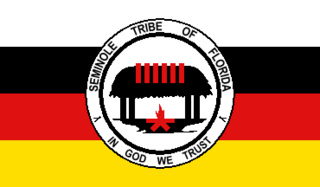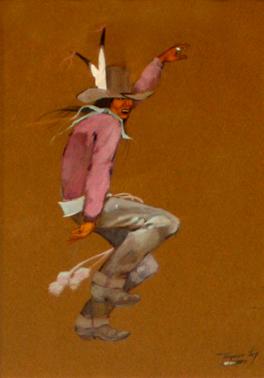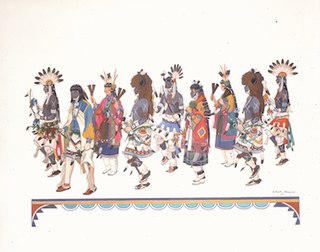
Osceola, named Billy Powell at birth in Alabama, became an influential leader of the Seminole people in Florida. His mother was Muscogee, and his great-grandfather was a Scotsman, James McQueen. He was reared by his mother in the Creek (Muscogee) tradition. When he was a child, they migrated to Florida with other Red Stick refugees, led by a relative, Peter McQueen, after their group's defeat in 1814 in the Creek Wars. There they became part of what was known as the Seminole people.

The Institute of American Indian Arts (IAIA) is a public tribal land-grant college in Santa Fe, New Mexico, United States. The college focuses on Native American art. It operates the Museum of Contemporary Native Arts (MoCNA), which is housed in the historic Santa Fe Federal Building, a landmark Pueblo Revival building listed on the National Register of Historic Places as Federal Building. The museum houses the National Collection of Contemporary Indian Art, with more than 7,000 items.

Acee Blue Eagle was a Native American artist, educator, dancer, and Native American flute player, who directed the art program at Bacone College. His birth name was Alexander C. McIntosh, he also went by Chebon Ahbulah, and Lumhee Holot-Tee, and was an enrolled member of the Muscogee (Creek) Nation.

The Seminole Tribe of Florida is a federally recognized Seminole tribe based in the U.S. state of Florida. Together with the Seminole Nation of Oklahoma and the Miccosukee Tribe of Indians of Florida, it is one of three federally recognized Seminole entities. It received that status in 1957. Today, it has six Indian reservations in Florida.

Pop Chalee, also known as Merina Lujan, was an American painter, muralist, performer, and singer. In 2021, she was inducted into the National Cowgirl Museum and Hall of Fame.
Stephen Mopope (1898–1974) was a Kiowa painter, dancer, and Native American flute player from Oklahoma. He was the most prolific member of the group of artists known as the Kiowa Six.
Lois Smoky Kaulaity (1907–1981) was a Kiowa beadwork artist and a painter, one of the Kiowa Six, from Oklahoma.

Mary Nimmo Moran was an American 19th-century landscape printmaker, specializing in etchings. The first woman to prove "marriage and family were not insurmountable to success." She was the first of many landscape artists and in 1880 she was known as a landscape etcher. She completed roughly 70 landscape etchings, which included scenes of England and Scotland, as well as Long Island, New York; New Jersey, Florida, and Pennsylvania. In 1881, she was one of eight Americans and the first female elected as a fellow to London's Royal Society of Painter-Etchers. Mary Nimmo Moran's landscape View of Newark from the Meadows is in the collection of The Newark Museum of Art. She was among the earliest American Artists to explore the medium of etching.
Walter Richard West Sr., was a painter, sculptor, and educator. He led the Art Department at Bacone College from 1947 to 1970. He later taught at Haskell Institute for several years. West was an enrolled citizen of the Cheyenne and Arapaho Tribes.
The Bacone school or Bacone style of painting, drawing, and printmaking is a Native American intertribal "Flatstyle" art movement, primarily from the mid-20th century in Eastern Oklahoma and named for Bacone College. This art movement bridges historical, tribally-specific pictorial painting and carving practices towards an intertribal Modernist style of easel painting. This style is also influenced by the art programs of Chilocco Indian School, north of Ponca City, Oklahoma, and Haskell Indian Industrial Training Institute, in Lawrence, Kansas and features a mix of Southeastern, Prairie, and Central Plains tribes.

Harrison Begay, also known as Haashké yah Níyá was a renowned Diné (Navajo) painter, printmaker, and illustrator. Begay specialized in watercolors, gouache, and silkscreen prints. At the time of his death in 2012, he was the last living, former student of Dorothy Dunn and Geronima C. Montoya at the Santa Fe Indian School. His work has won multiple awards and is exhibited in museums and private collections worldwide and he was among the most famous Diné artists of his generation.

Jerome Richard Tiger was a Muscogee Nation-Seminole painter from Oklahoma. Tiger produced hundreds of paintings from 1962 until his death in 1967.

Jennie Augusta Brownscombe was an American painter, designer, etcher, commercial artist, and illustrator. Brownscombe studied art for years in the United States and in Paris. She was a founding member, student and teacher at the Art Students League of New York. She made genre paintings, including revolutionary and colonial American history, most notably The First Thanksgiving held at Pilgrim Hall in Plymouth, Massachusetts. She sold the reproduction rights to more than 100 paintings, and images of her work have appeared on prints, calendars and greeting cards. Her works are in many public collections and museums. In 1899 she was described by New York World as "one of America's best artists."
Joe Hilario Herrera, was an American Pueblo painter, teacher, radio newscaster, politician, and a Pueblo activist; from a mixed Cochiti and San Ildefonso background. He was the son of the artist Tonita Peña, and had trained at the Santa Fe Indian School.

Solomon McCombs was a Native American artist from Oklahoma known for his paintings, murals, and illustrations.

Waldo Mootzka (1903–1940) was a Hopi watercolor artist.

José Vicente Aguilar, also called Sua Peen, is a Pueblo-American painter of San Ildefonso Pueblo and Picurís Pueblo heritage. He is known for his watercolor paintings. Aguilar has exhibited across the United States, particularly in the Southwest, and his work is in the permanent collection of institutions including the Gilcrease Museum.

Gilbert Benjamin Atencio, also called Wah Peen, was a San Ildefonso Pueblo painter, potter, medical Illustrator, and politician.

Lorencita Atencio Bird, also called T'o Pove, was a Pueblo-American painter and textile artist from the Ohkay Owingeh Pueblo. She studied at the Santa Fe Indian School under Dorothy Dunn and exhibited her artwork across the country and in Europe. In particular, she is known for her embroidery designs, utilizing symbolic colors and motifs such as diamonds, butterflies, and the color gold. Her artworks can be found in private collections including the Margretta S. Dietrich Collection and in museums including the Heard Museum, the Gilcrease Museum, the Philbrook Museum of Art, and the Wheelwright Museum of the American Indian.
Otis Polelonema (1902–1981), was a Hopi painter, illustrator, weaver, song composer, and educator. He lived in Shongopovi most of his life. He also worked as a WPA artist in the mural division. His native name in the Hopi language is Lomadamocvia which translates to "springtime".














